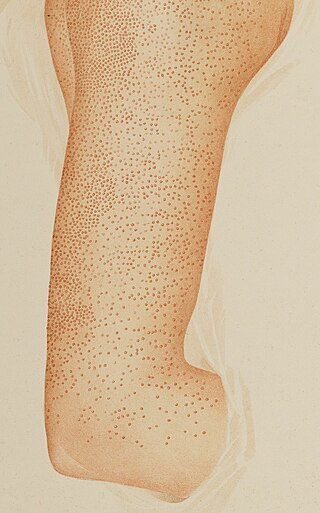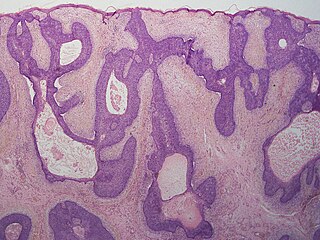Related Research Articles

Lichen planus (LP) is a chronic inflammatory and autoimmune disease that affects the skin, nails, hair, and mucous membranes. It is not an actual lichen, but is named for its appearance. It is characterized by polygonal, flat-topped, violaceous papules and plaques with overlying, reticulated, fine white scale, commonly affecting dorsal hands, flexural wrists and forearms, trunk, anterior lower legs and oral mucosa. The hue may be gray-brown in people with darker skin. Although there is a broad clinical range of LP manifestations, the skin and oral cavity remain as the major sites of involvement. The cause is unknown, but it is thought to be the result of an autoimmune process with an unknown initial trigger. There is no cure, but many different medications and procedures have been used in efforts to control the symptoms.

Darier's disease (DAR) is a rare, inherited skin disorder that presents with multiple greasy, crusting, thick brown bumps that merge into patches. It is an autosomal dominant disorder discovered by French dermatologist Ferdinand-Jean Darier.

Pityriasis rosea is a type of skin rash. Classically, it begins with a single red and slightly scaly area known as a "herald patch". This is then followed, days to weeks later, by an eruption of many smaller scaly spots; pinkish with a red edge in people with light skin and greyish in darker skin. About 20% of cases show atypical deviations from this pattern. It usually lasts less than three months and goes away without treatment. Sometimes malaise or a fever may occur before the start of the rash or itchiness, but often there are few other symptoms.

Lichen sclerosus (LS) is a chronic, inflammatory skin disease of unknown cause which can affect any body part of any person but has a strong preference for the genitals and is also known as balanitis xerotica obliterans (BXO) when it affects the penis. Lichen sclerosus is not contagious. There is a well-documented increase of skin cancer risk in LS, potentially improvable with treatment. LS in adult age women is normally incurable, but improvable with treatment, and often gets progressively worse if not treated properly. Most males with mild or intermediate disease restricted to foreskin or glans can be cured by either medical or surgical treatment.

Hyperkeratosis is thickening of the stratum corneum, often associated with the presence of an abnormal quantity of keratin, and is usually accompanied by an increase in the granular layer. As the corneum layer normally varies greatly in thickness in different sites, some experience is needed to assess minor degrees of hyperkeratosis.

Pityriasis rubra pilaris refers to a group of chronic disorders characterized by reddish orange, scaling plaques and keratotic follicular papules. Symptoms may include reddish-orange patches on the skin, severe flaking, uncomfortable itching, thickening of the skin on the feet and hands, and thickened bumps around hair follicles. For some, early symptoms may also include generalized swelling of the legs, feet and other parts of the body. PRP has a varied clinical progression and a varied rate of improvement. There is currently no known cause or cure for PRP.

Pearly penile papules are benign, small bumps or spots on the human penis. They vary in size from 1–4 mm, are pearly or flesh-colored, smooth and dome-topped or filiform, and appear in one or, several rows around the corona, the ridge of the head of the penis and sometimes on the penile shaft. They are painless, non-cancerous and not harmful. The medical condition of having such papules is called hirsutoid papillomatosis or hirsuties papillaris coronae glandis.

Prurigo nodularis (PN), also known as nodular prurigo, is a skin disorder characterized by pruritic (itchy), nodular lesions, which commonly appear on the trunk, arms and legs. Patients often present with multiple excoriated nodules caused by chronic scratching. Although the exact cause of PN is unknown, PN is associated with other dermatologic conditions such as untreated or severe atopic dermatitis and systemic causes of pruritus including liver disease and end stage kidney disease. The goal of treatment in PN is to decrease the itch sensation. PN is also known as Hyde prurigo nodularis, or Picker's nodules.
Tumid lupus erythematosus is a rare, but distinctive entity in which patients present with edematous erythematous plaques, usually on the trunk.
Kyrle disease is identified as a form of an acquired perforating disease. Other major perforating diseases are elastosis perforans serpiginosa and reactive perforating collagenosis. Recently, however, there is a controversy on categorizing Kyrle disease with perforating dermatosis or a subtype of acquired perforating collagenosis.
Perforating folliculitis is a skin condition in humans characterized by discrete follicular keratotic eruptions involving mainly the hairy parts of the extremities.

Acrokeratoelastoidosis of Costa or Acrokeratoelastoidosis is a hereditary form of marginal keratoderma, and can be defined as a palmoplantar keratoderma. It is distinguished by tiny, firm pearly or warty papules on the sides of the hands and, occasionally, the feet. It is less common than the hereditary type of marginal keratoderma, keratoelastoidosis marginalis.
Keratosis pilaris atropicans is a group of idiopathic genodermatoses that consists of three unique clinical entities: atrophoderma vermiculatum, keratosis follicularis spinulosa decalvans, and keratosis pilaris atrophicans faciei.
Traumatic anserine folliculosis is a curious gooseflesh-like follicular hyperkeratosis that may result from persistent pressure and lateral friction of one skin surface against another. Traumatic anserine folliculosis is caused by trauma. Topical keratolytics are the treatment of choice.
Alopecia mucinosa, also known as Follicular mucinosis, Mucinosis follicularis, Pinkus' follicular mucinosis, and Pinkus' follicular mucinosis–benign primary form, is a skin disorder that generally presents, but not exclusively, as erythematous plaques or flat patches without hair primarily on the scalp, neck and face. This can also be present on the body as a follicular mucinosis and may represent a systemic disease.

Warty dyskeratoma, also known as an Isolated dyskeratosis follicularis, is a benign epidermal proliferation with distinctive histologic findings that may mimic invasive squamous cell carcinoma and commonly manifests as an umbilicated lesion with a keratotic plug, WD have some histopathologic similarities to viral warts but it's not caused by HPV and the majority of these lesions display overall histopathologic features consistent with a follicular adnexal neoplasm. Usually limited to the head, neck, scalp or face and vulva. Lesions are generally solitary and sporadic and may be associated with a follicular unit. Oral involvement, particularly the hard palate, and genital involvement have been reported. it can also be thought of as one of the manifestations of focal acantholytic dyskeratosis, an epidermal reaction pattern that can be seen in several disorders, including Darier's disease and Grover's disease. But the main Difference between Darier disease and Warty dyskeratoma, is that Darier disease inherited dermatosis consisting of multiple keratotic papules on the face, trunk, and extremities, while WD occurs as an isolated, noninherited, single keratotic nodule mainly confined to the head and neck as mentioned earlier.

Frontal fibrosing alopecia is the frontotemporal hairline recession and eyebrow loss in postmenopausal women that is associated with perifollicular erythema, especially along the hairline. It is considered to be a clinical variant of lichen planopilaris.
Perforating granuloma annulare (PGA) is a skin condition of unknown cause, usually appearing on the dorsal hands, presenting as papules with a central keratotic core.

Basaloid follicular hamartoma is a cutaneous condition characterized as distinctive benign adnexal tumor that has several described variants. It manifest as small tan or brown coloured papules in the trunk, pubic area, face, scalp, and axilla.

Tumor of follicular infundibulum, also known as infundibuloma, and isthmicoma is a cutaneous condition characterized by flat, keratotic papules of the head and neck, skin lesions that are usually solitary.
References
- ↑ James, William; Berger, Timothy; Elston, Dirk (2005). Andrews' Diseases of the Skin: Clinical Dermatology. (10th ed.). Saunders. ISBN 0-7216-2921-0.
- ↑ Rapini, Ronald P.; Bolognia, Jean L.; Jorizzo, Joseph L. (2007). Dermatology: 2-Volume Set. St. Louis: Mosby. ISBN 978-1-4160-2999-1.
- 1 2 3 4 Aghighi, Maryam; Pukhalskaya, Tatsiana; Brickley, Sylvana; Smoller, Bruce (2020-06-12). "An Uncommon Case of Lichen Spinulosus in an Adult Patient Clinically Mmimicking Folliculotropic Mycosis Fungoides". Cureus. 12 (6). Springer Science and Business Media LLC: e8572. doi: 10.7759/cureus.8572 . ISSN 2168-8184. PMC 7358940 . PMID 32670708.